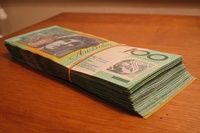UK likely to launch ‘wipe-clean’ plastic currency soon
11 Sep 2013
The Bank of England has launched a public consultation about introducing smaller, wipe-clean plastic banknotes, matching some currencies across the world.
 Depending on the reactions of the public, the central bank will take a decision in December for the introduction of the new plastic money by 2016.
Depending on the reactions of the public, the central bank will take a decision in December for the introduction of the new plastic money by 2016.
The Bank said the plastic notes with a see-through image of Britannia will be less tatty, tougher to counterfeit and last up to six times longer than the current cotton-paper based notes.
They will also be 15 per cent smaller, bringing English notes into line with sizes in other countries, but will remain larger than the current euro notes.
Thirty countries worldwide already use polymer banknotes - including Australia, which phased out paper money in 1996.
An Australian $5-note lasts over three years whereas the English fiver is reported to wear out in six months.
The public will have the chance to look at and feel the new notes at shopping centres across the country in a consultation process that starts immediately, with the new governor of the Bank of England, Mark Carney, taking a final decision on the go-ahead in December.
The Sir Winston Churchill £5-note will be the first to be made in polymer and will prospectively be launched in 2016, with the Jane Austen £10-note following in 2017.
All the notes will continue to feature the Queen and use existing colours.
Apart from Australia, plastic notes are being rolled out in Canada, Carney's home country; but the Bank said its polymer project began long before the new governor was appointed. It said it has spent three years studying the impacts of a change from cotton paper.
Scotland and Northern Ireland, where seven banks have the right to issue notes, will be free to continue with paper notes.
The Bank of England said that in tests, the new plastic notes do not melt until at least 120C and survive washing machines much better than existing paper notes. Despite being made from polymer pellets, the Bank said the notes will be more environmentally friendly as the manufacturing process does not use the same intensity of water as cotton-paper manufacture.
The new notes will cost around 50 per cent more to produce, but the Bank estimates it will save £100 million as the notes will need replacement far less frequently.
But the Bank ruled out importing plastic money. The notes will continue to be produced at the Bank's ultra-secure plant in Debden, Essex, although subcontracted to a private company, likely to be either De La Rue, the existing maker, or Innovia, which manufactures most of the polymer notes currently in circulation across the world.
The deputy governor of the Bank of England, Charles Bean, said there was no question that the introduction of plastic notes was a "done deal" and promised to listen to feedback from the public before going ahead.
In recognition of the need for groups such as the blind to handle the change, the Bank will continue to issue notes in size-ascending order, so the new fivers and tenners will continue to be slightly different in size.
There is no switchover date yet proposed for when or if £20 notes – the most common note in circulation – will be changed to polymer.
In Canada, where high-value notes are already made of polymer and lower-denomination notes will be introduced later this year, there have been some complaints that the notes tend to stick to each other. But the Bank of England said it did not expect this to be an issue, although it did accept that brand new notes will have a more slippery texture than cotton-paper ones.
The extended time scale for the introduction of the notes has been put in place to allow the cash handling industry, retailers and ATM and vending machine operators time to manage the transition.
ATMs will be able to hold, say paper £20-notes and plastic £10 notes, but will not able to issue plastic £10-notes alongside paper £10-notes as they will be different sizes. But because the polymer notes will be thinner, cash machines will be able to stock more, and operators say the machines will be less likely to jam.
But it is security and counterfeiting that the Bank of England places at the heart of the new notes. Evidence from Australia and other countries such as New Zealand, Singapore, Mexico and Nigeria, where polymer notes are common, is that after their introduction counterfeiting reduced substantially. Last year the Bank of England removed 719,000 counterfeit notes from circulation, a relatively high rate compared with other countries.
Shoppers in Northern Ireland will already be familiar with polymer notes, since a limited-edition note was circulated in 2000 by Northern Bank to mark the millennium.
If the new notes go ahead, removal of paper notes is expected to be relatively swift, taking no more than eight months.







.webp)














